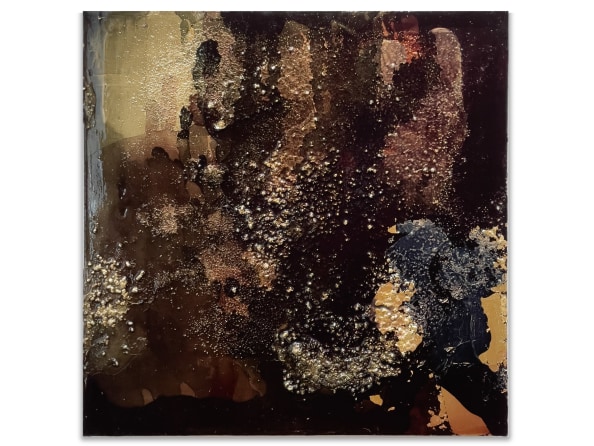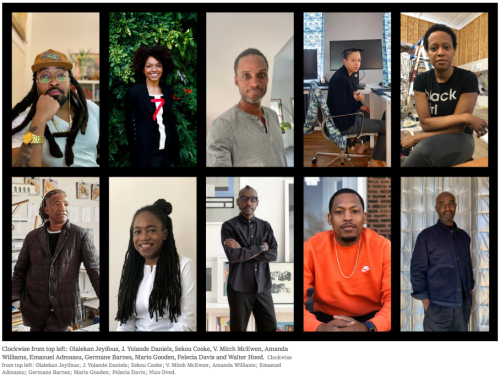

What’s below is a conversation with members of the Black Reconstruction Collective, which came together during the past year and a half, in tandem with an exhibition now at the Museum of Modern Art called “Reconstructions: Architecture and Blackness in America.” The collective’s members are the 10 architects, artists and designers in the exhibition.
The show includes some mind-bending, beautiful work, on view through the end of May. But the collective emerged to serve longer-term, more radical goals.
It taps into a legacy of Black collectives from earlier eras. In 1893, Ida B. Wells and Frederick Douglass joined to publish “The Reason Why the Colored American Is Not in the World’s Columbian Exposition.” Seven years later, W.E.B. Du Bois, Booker T. Washington and Thomas J. Calloway organized a display of chartsand photographs about the African-American experience to counter depictions of Black Americans at the world’s fair in Paris.
These were necessary responses to a system of cultural exclusion that, time and again, erased, demeaned and denied Blackness. By the 1960s, in the wake of the Black Power movement, a variety of Black artists’ collectives had coalesced, among them Spiral, which included Norman Lewis and Romare Bearden; Amiri Baraka’s Black Arts Movement; and AfriCobra, a Chicago-based Black artists’ commune.
“We have a responsibility beyond the exhibition, beyond us,” is how Amanda Williams, a Chicago-based architect and artist, and one of the members of the Black Reconstruction Collective, summed up the group’s thinking.
The MoMA show was organized by Sean Anderson, an associate curator at the museum, and Mabel O. Wilson, an architect, Columbia University professor and author, among much else, of “White by Design,” which describes the Modern’s failure to display and collect works by Black architects and designers.
“Reconstructions” proceeds from a question: “How do we construct Blackness?” The architects enlisted to answer this question are a multigenerational mix, including some familiar names. Nearly all run small or solo practices.
Their projects occupy rooms at the Modern dedicated to Philip Johnson, the New York power broker, architect and founding director of MoMA’s architecture department, who died in 2005, at 98. Members of the collective petitioned the museum to remove Johnson’s name from the wall because of his history of racism and Nazi sympathy. The museum declined. “Manifesting Statement,” a textile by the collective, temporarily covers the name up.
Other works in the show remap Los Angeles according to Black settlement patterns. They picture a mile-long stretch of Oakland rebuilt according to principles outlined in the Black Panthers’ 10 Point Program. They contemplate how Black people might “navigate their way to free space,” which can take the form of the open sea or outer space — a project that also recalls Kinloch, Mo. Having thrived for generations as an incorporated Black town, Kinloch ended up a victim of urbicide when authorities in neighboring St. Louis converted town land to build an airport.
All of these projects reimagine architecture from the perspective of Black people, a mission of the collective — and a first for the Modern. Until now, the museum hasn’t devoted any exhibition to African-American architects. There is nothing in its permanent collection by major Black architects like Paul Revere Williams, J. Max Bond Jr., Vertner Woodson Tandy or Amaza Lee Meredith. Since 1929, when MoMA opened its doors, it has acquired only two works by Black designers, both since 2016, neither of them strictly architecture: one is Charles Harrison’s “View-master (model G)” from 1962, the other a series of photographs by Amanda Williams.
Which is to say, the Modern itself partly necessitated the Black Reconstruction Collective. The group addresses the bigger question: How can Blackness construct America? Four of the members gathered on Zoom the other day to talk about the collective’s impetus and goals: Amanda Williams, Emanuel Admassu, J. Yolande Daniels and V. Mitch McEwen. The four were chosen as representatives by the other members: Sekou Cooke, Germane Barnes, Felecia Davis, Mario Gooden, Walter Hood and Olalekan Jeyifous.
The following is an edited, condensed version of the conversation.